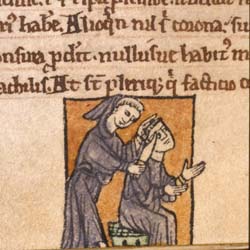 |
 |
 |
 |
 |
 |
 |
|
|
Cistercian Abbeys: DORE Name: DORE Location: Abbey Dore,
nr Hereford County: Herefordshire Dore abbey was established in the ‘Golden Valley’ of south-west Hereford in 1147 and was colonised by monks from Morimond Abbey in the Champagne region of north-eastern France.(1) When the monks arrived from Morimond they found themselves on the border lordship of Ewyas Harold, owned by Robert fitz Harold of Ewyas, who became the first patron of Dore. Dore was the only British house to be colonised by Morimond, although in turn it was to send out three colonies of its own: Trawscoed (in Wales, 1173), although this house was aborted in the early years of the thirteenth century and the site was subsequently worked as a grange, Grace Dieu (1226) and Darnhall (1274) which later moved to Vale Royal.(2) Apart from the estates in the Golden Valley, Dore abbey was to acquire a number of valuable properties in Wales. Gerald of Wales claimed that Abbot Adam I (c. 1186 – 1216) was a devious individual intent on acquiring property by any means, fair or foul. He also believed that the monks of Dore carried off humbler folk from nearby villages who were dying and ‘by corrupt persuasion’ wheeled them to their abbeys and then took their possessions. During the first half of the fourteenth century the abbey was headed by a rather more respectable character, Richard Straddell (d. 1346). Abbot Richard was a distinguished scholar and theologian and at times served as a diplomat for both the crown and the Cistercian General Chapter.(3) In 1321 he was given a relic of the Holy Cross by William de Gradisson, and it was said that crowds visited the abbey to see this. Lady Matilda de Bohun’s tomb (1318) was also a focal point of the abbey as it was thought to have had the power of healing. Despite these attractions the house was never
a particularly rich one, and its later history witnessed a series
of financial difficulties, coupled with a collapse in internal
discipline. In the survey of 1535 the net annual income was valued
at £101
and the house was dissolved a year later.(4) Following
the Dissolution, a sale of goods was held at Dore and by 1545
John Scudamore had
acquired the site of the abbey together with some surrounding property.
The east end of the church was preserved so that it might serve
the parish, however, the nave, together with most of the cloister
buildings, were left to fall into ruin. In 1633 the owner, Viscount
Scudamore, decided to restore what was left of the abbey church
and convert it for use as the local parish church. A tower was
added,
the interior refurbished with carved oak, a fine Renaissance screen
inserted, and many windows replaced with seventeenth-century stained
glass. By the end of the nineteenth century the church was again
in need of attention, and the repairs were carried out by Roland
Paul in 1901-09. The medieval presbytery is one of the finest Cistercian
survivals in the West of Britain, and the interior dates from
the
restoration of the church in the earl 1630s. The remains comprise
the crossing and the liturgical east end of the monastic church,
and there are still slight traces of the nave, and fragments of
the claustral buildings. The church and the ruins are both open
to the public and accessible at all reasonable times.(5)
|
